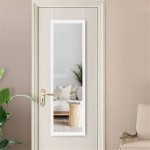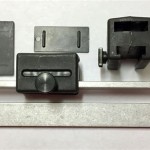Standard Mirror Sizes: A Comprehensive Guide
Choosing the right mirror involves more than just aesthetics. Practical considerations, such as available space and intended function, play a crucial role. Understanding standard mirror sizes simplifies the selection process, whether for a bathroom vanity, a full-length dressing mirror, or a decorative wall piece.
Common Bathroom Mirror Sizes
Bathroom mirrors are typically dictated by the size of the vanity. Common vanity widths range from 24 inches to 72 inches. The mirror should be slightly narrower than the vanity itself, leaving a small border on either side.
- 24-inch wide mirrors: Ideal for smaller bathrooms or powder rooms.
- 30-inch wide mirrors: A versatile size suitable for many standard vanities.
- 36-inch wide mirrors: Well-suited for larger single vanities or double vanities.
- 48-inch wide mirrors: Commonly used with double vanities or larger bathroom spaces.
- 60-inch and 72-inch wide mirrors: Best suited for expansive double vanities or as statement pieces.
Standard bathroom mirror heights typically range from 24 to 40 inches. The height should complement the ceiling height and overall bathroom proportions.
Full-Length Mirror Dimensions
Full-length mirrors are essential for checking one's overall appearance. These mirrors are designed to reflect the entire body, from head to toe.
- Standard widths: Common widths range from 14 inches to 24 inches, offering ample viewing space without consuming excessive floor space.
- Standard heights: Heights typically range from 48 inches to 72 inches, ensuring a complete view of the body.
- Placement considerations: Full-length mirrors can be leaned against a wall, mounted on a door, or incorporated into a wardrobe or dressing area.
Decorative Mirror Sizes
Decorative mirrors contribute to a room's ambiance and visual appeal. Their sizes vary greatly depending on the desired effect.
- Small decorative mirrors: Can be grouped together to create a gallery wall or used individually to accent specific areas.
- Large decorative mirrors: Can serve as focal points, visually expanding a room and reflecting light to enhance brightness.
- Shapes and sizes: Decorative mirrors come in a wide variety of shapes, including round, oval, square, rectangular, and more unconventional designs, allowing for creative expression.
Over-the-Mirror Medicine Cabinets
Combining functionality and practicality, over-the-mirror medicine cabinets provide storage space while serving as a bathroom mirror.
- Typical widths: Medicine cabinet widths commonly correspond to standard vanity sizes, ranging from 18 inches to 48 inches.
- Standard heights: Heights typically range from 24 inches to 36 inches, providing adequate storage for toiletries and medications.
- Recessed or surface-mounted: Medicine cabinets can be recessed into the wall for a flush finish or surface-mounted for easier installation.
Custom Mirror Sizes
While standard sizes cater to most needs, custom sizing provides flexibility for unique spaces or design preferences. Many manufacturers offer custom mirror cutting services.
- Specific dimensions: Custom mirrors allow for precise measurements to fit non-standard spaces or architectural features.
- Unique shapes: Custom cutting allows for the creation of mirrors with irregular shapes or intricate designs.
- Considerations for custom orders: Lead times and costs for custom mirrors may vary depending on the complexity of the project.
Choosing the Right Mirror Size
Selecting the appropriate mirror size depends on several factors:
- Wall space: Measure the available wall space carefully to ensure the mirror fits comfortably without overwhelming the area.
- Purpose: Consider the intended use of the mirror. A bathroom vanity mirror will have different size requirements than a full-length dressing mirror.
- Existing fixtures: Take into account the size and placement of existing fixtures, such as sinks, lighting, and other bathroom accessories.
Mirror Thickness
Mirror thickness influences its durability and resistance to warping. Common thicknesses range from 3/16 inch to 1/4 inch for standard mirrors. Thicker mirrors, such as 1/2 inch or 3/4 inch, are often used for larger sizes or in applications where increased strength is required.
- Standard thickness: 1/4 inch is a common thickness for many wall-mounted and vanity mirrors.
- Thicker mirrors: Larger, heavier mirrors often require a thicker glass to prevent warping or distortion.
- Thinner mirrors: Smaller, lighter mirrors can often utilize thinner glass.
Mirror Installation
Proper installation is crucial for the safety and longevity of a mirror. Consult a professional for complex installations or large, heavy mirrors.

How To Measure Your Space For A Large Wall Mirror 2 Steps

Laser Cut 4u C U In Me Mirrors

Bathroom Mirror Size Calculator Vanity Sizes Double Rectangular

Bathroom Mirror Size Calculator

Bathroom Mirror Size Calculator

Panduan Lemari Cermin Dan Kohler

Rectangular Bathroom Mirrors Bevelled Designer Wall Mounted Aica Bathrooms

How To Measure Your Space For A Large Wall Mirror 2 Steps

Standard Bathroom Vanity Mirror Height Google Search Sizes Measurements Remodel Master

Standard Sizes And Dimensions Of Home Furniture Engineering Discoveries Dressing Table Mirror Design








